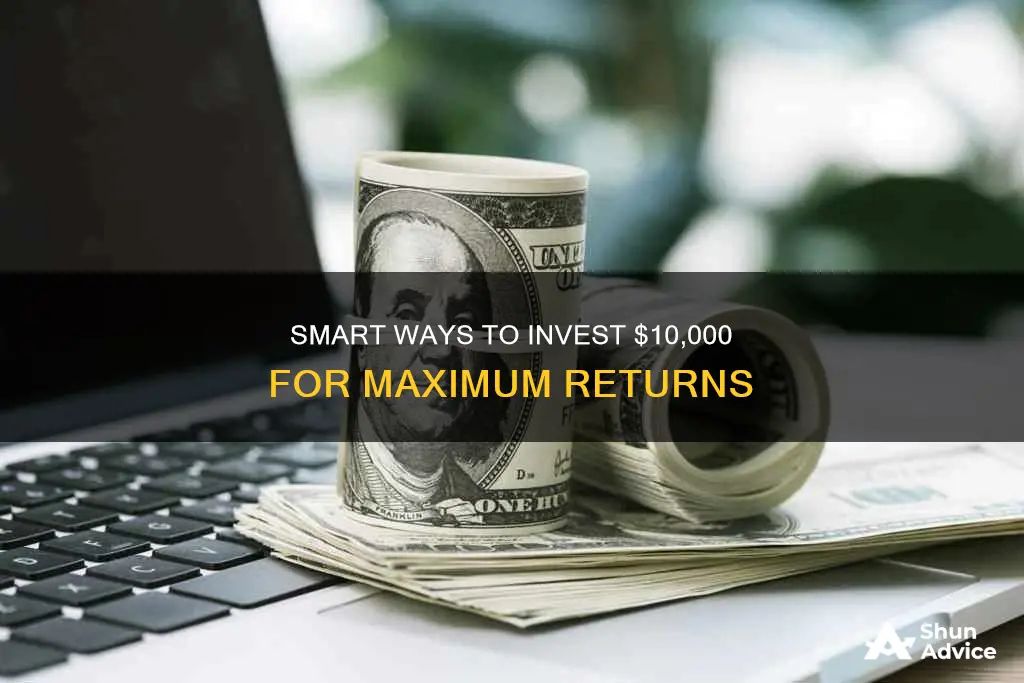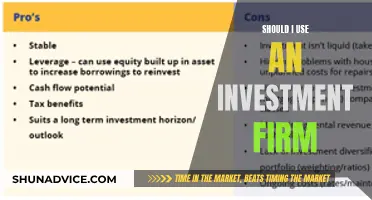
Investing $10,000 can be a great way to build wealth for the future. While it may not seem like a life-changing amount of money, if invested wisely, it can grow into a substantial nest egg over time. Here are some options to consider when deciding how to invest $10,000:
- Pay off high-interest debt: Paying off debt may not seem like a traditional investment, but it can save you a significant amount in interest charges. By reducing your debt, you free up more money to invest in other opportunities.
- Build an emergency fund: Having a stash of cash set aside for unexpected expenses, such as medical bills or job loss, is crucial for financial security. Most experts recommend saving at least three to six months' worth of living expenses.
- Invest in a 401(k) or IRA: If your employer offers a 401(k) match, take advantage of it. It's essentially free money and a guaranteed return on your investment. If you don't have access to a 401(k), consider opening and funding an individual retirement account (IRA).
- Invest in mutual funds or ETFs: Mutual funds and exchange-traded funds (ETFs) offer an easy way to diversify your investments across different assets. ETFs tend to have lower fees and minimum requirements, making them ideal for new investors.
- Real estate investment trusts (REITs): If you're interested in real estate investing but don't have the capital or experience to buy property directly, REITs are a great option. They allow you to invest in a portfolio of real estate properties, typically commercial properties, and provide regular dividends.
- High-yield savings account: If you want to keep your money liquid and accessible, a high-yield savings account can provide a decent return while allowing you to quickly access your funds whenever needed.
- Health Savings Account (HSA): If you have a high-deductible health plan, an HSA offers tax benefits and a way to save for future healthcare expenses. Contributions are tax-deductible, and the money grows tax-free until withdrawn for qualified medical expenses.
- Invest in yourself: This could mean anything from investing in your education, learning new skills, starting a business, or prioritising your physical and mental health. Improving yourself can have a significant impact on your quality of life and future earnings potential.
| Characteristics | Values |
|---|---|
| Investment Type | Emergency Fund, High-Yield Savings Account, Mutual Funds, ETFs, 401(k), IRA, Health Savings Account, Real Estate Investment Trusts, Peer-to-Peer Lending, etc. |
| Investment Horizon | Short-term (Emergency Fund, High-Yield Savings Account), Medium-term (Mutual Funds, ETFs, 401(k), IRA), Long-term (Real Estate Investment Trusts, Health Savings Account) |
| Risk Level | Low (High-Yield Savings Account, 401(k), IRA, Health Savings Account), Medium (Mutual Funds, ETFs), High (Real Estate Investment Trusts, Peer-to-Peer Lending) |
| Returns | Varies depending on the investment type and horizon |
| Accessibility | Varies depending on the investment type and horizon |
What You'll Learn

Invest in stocks and shares
Investing in stocks and shares is a great way to grow your money. Here are some tips on how to invest $10,000 in stocks and shares:
Determine Your Investment Style
Before investing, it's important to understand your investment style. If you want a hands-off approach, consider using a robo-advisor, which offers complete portfolio management through computer algorithms that manage your investments based on your goals. On the other hand, if you prefer a more hands-on approach, you can choose to invest in individual stocks or funds yourself.
Set Clear Goals
It's crucial to define your investment goals. Are you investing for the short term or the long term? If you need the money within the next five years, it's generally recommended to keep it out of the stock market and opt for more conservative investment options or savings accounts. However, if you're investing for the long term, such as for retirement, investing in stocks and shares can be a great way to grow your money over time.
Diversify Your Portfolio
When investing in stocks, it's important to diversify your portfolio to minimise risk. Instead of investing all your money in a single stock or industry, spread your investments across different sectors and industries. This helps protect your portfolio from significant losses if a particular stock or industry underperforms.
Choose Individual Stocks Carefully
When selecting individual stocks, consider investing in well-known, established companies with a strong track record. These companies tend to be less volatile, and their share prices are less likely to experience drastic fluctuations. Additionally, look for companies with growing profits and positive earnings per share (EPS). You can find this information on financial websites or by analysing the company's financial reports.
Consider Using Dollar-Cost Averaging
Dollar-cost averaging is an investment strategy where you invest a fixed amount of money at regular intervals, regardless of the share price. By doing this, you buy more shares when the price is low and fewer shares when the price is high, averaging out your purchase price over time. This strategy helps to reduce the impact of market volatility and can lead to better returns over the long term.
Monitor Your Investments Regularly
Regularly review the performance of the companies you've invested in. Keep an eye on their earnings reports and profit outlook. If a company's profits start to decline or are expected to stop growing, it may be a sign to sell your shares and reallocate your investments.
Consider Using a Brokerage Account
Using a brokerage account can give you access to a wide range of investment options, including stocks, funds, and other financial instruments. You can open a brokerage account with an online broker, which often offers commission-free trades and a variety of investment choices to build a diversified portfolio.
Practice Discipline and Patience
Resist the urge to frequently trade your stocks. Investing in the stock market requires a long-term perspective. While there may be short-term fluctuations, hold on to your shares if you believe in the companies you've invested in. Remember, investing in stocks is a long-term strategy, and it's important to remain disciplined and patient during market ups and downs.
Cashing in on Investments: A Meryl Lynch Guide
You may want to see also

Pay off high-interest debt
Paying off high-interest debt is one of the best ways to invest your $10,000. Here's why:
You'll Save Money in the Long Run
High-interest debt, such as credit card debt, can be costly in the long run. By paying off this debt, you'll save money on interest. The longer you take to pay off this debt, the more money you'll lose to interest. So, it's a good idea to tackle it head-on with your $10,000.
It's a Great Return on Investment (ROI)
Imagine you have a $10,000 debt at a 15% interest rate. If you pay $250 per month, it will take you almost five years to pay off, and you'll end up paying close to $4,000 in interest charges. However, if you use your $10,000 to pay off this debt, you'll save almost $4,000 over the next five years. That's a fantastic return on your investment!
It Provides Psychological Benefits
Paying off high-interest debt can also have psychological benefits. The "debt snowball method" is a strategy where you focus on paying off the smallest debt first, regardless of the interest rate. This method helps you gain quick wins and stay motivated to tackle the larger debts. It's all about building momentum and keeping your eyes on manageable goals.
It Improves Your Cash Flow
Paying off high-interest debt can improve your cash flow and free up money for other financial goals. Once you're no longer burdened by high-interest payments, you'll have more money each month to invest, save, or spend on other priorities.
It Reduces Stress and Improves Your Quality of Life
Debt can be a significant source of stress and anxiety. By paying off high-interest debt, you'll reduce this financial burden and improve your overall quality of life. You'll have more financial freedom and flexibility to make choices that align with your values and goals.
In summary, paying off high-interest debt is a smart way to invest $10,000. It will save you money, provide a great ROI, boost your motivation, improve your cash flow, and reduce stress. It's a decision that will positively impact your financial situation and overall well-being.
Cashing Out Investments: Using the Cash App to Withdraw Funds
You may want to see also

Put it in a high-yield savings account
If you have $10,000 to invest, one option is to put it in a high-yield savings account. This is a good option if you need to use the money within the next two years, such as for an emergency, wedding, car upgrade, or house purchase. It's also a good temporary solution if you're still deciding on a longer-term strategy.
High-yield savings accounts offer a good balance of easy access to your money and a competitive rate of return. The yields are variable, meaning the bank can raise or lower them at will. They tend to increase when the Federal Reserve raises rates and decrease when the Fed lowers rates.
In the current rate environment of 2024, high-yield savings accounts are paying around 5% interest. This means that $10,000 in such an account would earn you about $500 in interest over a year. This is a much better return than the national average savings account rate of 0.57%, which would only earn you around $57 in interest over a year, or the rock-bottom rate of 0.01% offered by some big banks, which would earn you just $1.
Online-only banks tend to offer higher interest rates than big brick-and-mortar banks, as they don't have the same overhead costs of maintaining branches. Some online banks that offer competitive rates include Ally Bank, Quontic Bank, and Marcus by Goldman Sachs.
It's important to note that high-yield savings accounts may not always be the best option. In a falling-rate environment, for example, you might be better off with a fixed-rate certificate of deposit (CD) to lock in a higher rate. Additionally, it's possible to earn higher interest rates by investing in certain stocks or other assets, although these options usually come with higher risk.
Journaling a Large Cash Investment: A Step-by-Step Guide
You may want to see also

Invest in mutual funds and ETFs
Mutual funds and exchange-traded funds (ETFs) are an excellent option for investing $10,000. These investment vehicles provide instant diversification, allowing you to spread your risk across a wide range of assets.
Mutual funds are a large pool of investments managed by professionals. They typically require a minimum investment of around $3,000 and can have high load fees, ranging from 1% to 3% of your investment. However, $10,000 is more than enough to get started with mutual funds and provides access to several options.
ETFs, on the other hand, are similar to mutual funds but trade on an exchange like regular stocks. They tend to have lower fees and minimum investment requirements, making them ideal for new investors. With ETFs, you can invest as little as the price of one share, which could be as low as $50.
Both mutual funds and ETFs offer exposure to a diverse range of stocks or bonds, aiming to achieve specific investment goals. These funds are managed by professionals who handle the complex task of keeping the portfolio on track, in exchange for a small annual expense ratio.
When investing in mutual funds and ETFs, it's essential to consider factors such as the fund's expenses, taxes, and investment minimums. Expenses can vary significantly between funds tracking similar indexes, so it's important to compare and choose funds with lower expense ratios. Additionally, mutual funds tend to be less tax-efficient than ETFs due to taxable capital gains distributions at the end of the year.
When deciding where to buy mutual funds and ETFs, consider using a robo-advisor or an online broker. Robo-advisors, such as Acorns and Wealthfront, use algorithms to automatically build and manage your portfolio, typically at lower fees than traditional financial advisors. Online brokers like Robinhood offer commission-free trades and a variety of investment options to build a diversified portfolio.
By investing in mutual funds and ETFs, you can benefit from instant diversification, professional management, and access to a wide range of investment options.
Investing Activities: Statement of Cash Flows Impact
You may want to see also

Invest in yourself
Investing in yourself is an excellent way to use your $10,000. Here are some ideas to consider:
Education
Consider investing in your education by going back to school, getting a new certification, or attending conferences and workshops related to your field. This could help you advance in your career, learn new skills, and increase your earning potential.
Debt Repayment
If you have any high-interest debt, such as student loans or credit card debt, using your $10,000 to pay off these balances can be a smart move. Getting rid of high-interest debt will save you money in the long run and free up your monthly cash flow, giving you more financial flexibility.
Career Development
Investing in your career can pay off in the long term. Consider using the money to hire a career coach, join professional organizations, or attend networking events. These investments can help you build valuable connections, gain access to new opportunities, and potentially increase your earning power over time.
Health and Wellness
Investing in your health and wellness is another way to invest in yourself. Consider using the money to join a gym or health club, purchase home workout equipment, or sign up for wellness programs or activities that promote physical and mental well-being. Investing in your health can lead to improved productivity, reduced stress, and potentially lower healthcare costs in the long run.
Personal Development
Personal development opportunities can also be a worthwhile investment. Consider using the funds to hire a life coach, take up a new hobby or skill, or pursue activities that align with your passions and interests. These investments can lead to increased self-awareness, improved decision-making abilities, and a higher quality of life.
Finding Initial Investment: Utilizing Positive Cash Flow Strategies
You may want to see also
Frequently asked questions
Some safe investment options for $10,000 include high-yield savings accounts, money market accounts, and certificates of deposit (CDs).
You can invest $10,000 in the stock market through a brokerage account or a robo-advisor. You can invest in mutual funds, exchange-traded funds (ETFs), or individual stocks. It is important to diversify your investments to manage risk.
Some alternative investment options include real estate investment trusts (REITs), peer-to-peer lending, and health savings accounts (HSAs).
Paying off high-interest debt can be a good investment, as it saves you money on interest charges. However, it is important to consider your financial goals and other investment opportunities before making a decision.







